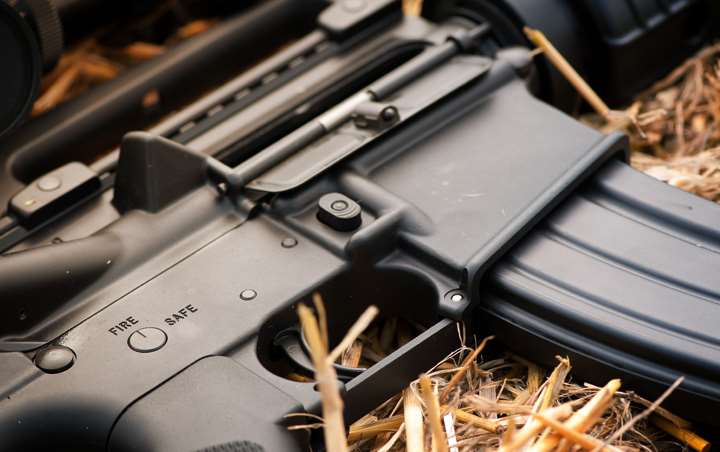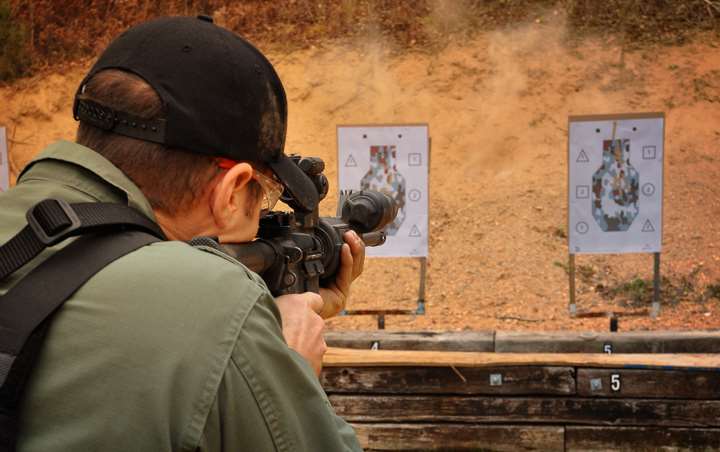
I was on a pig hunt a couple of weeks ago and watched from a distance as a friend tried to zero his rifle (for the uninitiated, zeroing is the process of ensuring the bullet is hitting the intended point of impact). This is someone who should have known better, but he was trying to cut some corners in order to make things happen faster. In fact, his approach made the process take much longer than necessary. The whole thing made me want to convey to SHARP readers the zeroing process that I have honed through good times and bad.
For the purposes of this discussion, we are going to assume the rifle is an AR-style platform with a standard sort of magnified scope. Let’s just say that it’s a fixed 10 power Leupold Mark 4. The rifle has not been shot since the scope was mounted, so the point of impact relative to the scope reticle is unknown (I’m not going to get into boresighting here). The scope crosshairs are centered about two inches higher than the rifle’s bore (called scope offset).
The first thing I will do when I get to the range is put a target out at a mere 10 yards from my shooting position. My friend made the mistake of putting his
target out at 100 yards. When he shot, he experienced no impacts on the target. He then moved the target back to 50 yards and had the same effect. His target was at 20 yards before he finally had bullets on paper. This was wasted time and energy that can always be prevented by starting at 10 yards.
Let’s say that the first bullet I shoot hits 4” low of my desired point of impact. This will make things fairly easy. If I had gotten lucky and everything was perfect, I would have expected the bullet to be about 1.5” to 2” low. This is because of the scope offset mentioned earlier.
To understand this, imagine shooting a target that is placed one inch in front of your rifle muzzle. You are looking through the scope at the bullseye, but the bullet is exiting the muzzle two inches below where your crosshairs are centered. It will necessarily hit the target two inches lower than the bullseye.
In this example, there is no time and space for the bullet to close the gap as it is launched on an upward trajectory. However, once the target is out at, let’s say 100 yards, it has plenty of travel distance to make it up to that bullseye that is in the center of your scope. We should all remember here that bullets fall as soon as they leave the muzzle. They never “go up.” Rockets do that. We launch bullets at an upward angle in order to hit distant targets. Unlike me and my spectacular 13.26” vertical, bullets are not exempt from the laws of physics.
Getting back to business, the impact is 4” low at 10 yards. I would like to be 1.75” low at this point because those ten yards did allow my bullet to close some of the scope offset gap. My scope has .25 MOA adjustments. This means that at 100 yards, each “click” of the scope will move the bullet impact .25”. Of course, four “clicks” moves impact an inch.
So, if I am now 2.25” lower than I would like to be at 10 yards, I translate that to how far off it would be at 100 yards so I can more easily determine how many “clicks” I need to turn into the scope. I multiply 2.25 by 10. This should make sense if you think about the bullet flying on a constant angle … the distance between the actual point of bullet impact on the target and the intended point grows at a constant rate as distance of bullet travel increases. It doubles as the shooting distance doubles.
If I moved the target to 100 yards, before making any adjustments to the scope, my math tells me I would expect the bullet to impact 22.5” low. If four clicks will move the bullet one inch, I need to turn 90 “clicks” of elevation into my scope (22.5x4). With my target still at 10 yards, I shoot again to verify everything is right. This helps prevent unnecessary target movement if I do something silly like accidently turning the scope down instead of up. Realizing a mistake like this after moving the target is frustrating. It’s something my friend did while I watched him on his painful saga before our pig hunt.
At this point, my bullet should impact right where I want it. There might be some minor adjustments necessary after such dramatic scope manipulation, but we only want to be nice and close at 10 yards. I then back my target to 50 yards for a little more fine-tuning. I would like to be about one inch low at this point because my bullet’s upward trajectory is still closing the scope offset gap.
Instead of firing only one shot here, I will fire three and use the center of the three-shot group as my single point determining how much I have to adjust the scope. This prevents the comical folly associated with “chasing” bullets and accounts for a number of variables associated with a bullet’s trip from chamber to target.
If the center of the group is one inch left and one inch low, I would not do anything to the elevation but I would want to move impact one inch right. It’s important at this point for me to suppress my Type-A personality. A half of an inch here or there really is OK.Since the target is only half the distance to the 100-yard line, this is really two inches for purposes of determining the number of “clicks” I need to turn into the scope. The scope must therefore have eight clicks right turned into it.
I then shoot the gun one last time at 50 yards to make sure I made no mistakes in my adjustment process. If all is good, I then move the target to 100 yards. The bullet should be right at the bullseye if my intention is to zero the rifle to be dead-on at this distance. I shoot another three-shot group and use the center of the group as my true point of impact. Minor adjustments get made until the center of any three-shot group is my intended point of impact.
It’s important at this point for me to suppress my Type-A personality. A half of an inch here or there really is OK. Most rifles cannot shoot any better than this anyhow. Coming to accept this has been a little painful, but I have. Now that the target is at 100 yards, a one-inch adjustment is only four “clicks.” It’s as easy as that.
My hope is that detailing this process will help others from experiencing the zeroing nightmare that virtually every rifle owner has experienced at one time or another. There might be a better way to do it, but this is the one that I’ve decided is best for me, at least until someone else shows me a better approach.
LaSorte has been shooting regularly since he was four years old and has grown into a competitive shooter, adventure hunter and NRA Certified Instructor. There is nothing he enjoys more than acquiring and sharing knowledge associated with shooting and self-defense. Empowering others, especially women, through an introduction to what he calls the “beautiful world” of shooting is his passion.
































